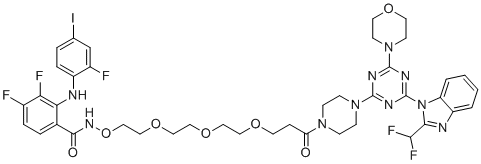
ST-168
CAS No. 2126038-25-1
ST-168 ( ST168 )
Catalog No. M13380 CAS No. 2126038-25-1
ST-168 is a novel potent, orally available MEK/PI3K bifunctional inhibitor.
Purity : >98% (HPLC)
 COA
COA
 Datasheet
Datasheet
 HNMR
HNMR
 HPLC
HPLC
 MSDS
MSDS
 Handing Instructions
Handing Instructions
| Size | Price / USD | Stock | Quantity |
| 100MG | Get Quote | Get Quote |


|
| 200MG | Get Quote | Get Quote |


|
| 500MG | Get Quote | Get Quote |


|
| 1G | Get Quote | Get Quote |


|
Biological Information
-
Product NameST-168
-
NoteResearch use only, not for human use.
-
Brief DescriptionST-168 is a novel potent, orally available MEK/PI3K bifunctional inhibitor.
-
DescriptionST-168 is a novel potent, orally available MEK/PI3K bifunctional inhibitor with IC50 of 182, 69.2, 1482, 2293, and 41.7 nM for MEK1, PI3Kα, PI3Kβ, PI3Kγ, and PI3Kδ, respectively; exhibits improved inhibition toward PI3K isoforms compared to ST-162; demonstrates superior tumoricidal efficacy over ST-162 in an A375 melanoma spheroid tumor model.
-
SynonymsST168
-
PathwayPI3K/Akt/mTOR signaling
-
TargetPI3K
-
RecptorPI3K
-
Research Area——
-
Indication——
Chemical Information
-
CAS Number2126038-25-1
-
Formula Weight1010.76
-
Molecular FormulaC41H44F5IN10O7
-
Purity>98% (HPLC)
-
Solubility——
-
SMILES——
-
Chemical NameN-(2-(2-(2-(3-(4-(4-(2-(difluoromethyl)-1H-benzo[d]imidazol-1-yl)-6-morpholino-1,3,5-triazin-2-yl)piperazin-1-yl)-3-oxopropoxy)ethoxy)ethoxy)ethoxy)-3,4-difluoro-2-((2-fluoro-4-iodophenyl)amino)benzamide
Shipping & Storage Information
-
Storage(-20℃)
-
ShippingWith Ice Pack
-
Stability≥ 2 years
Reference
1. Van Dort ME, et al. ACS Med Chem Lett. 2017 Jul 24;8(8):808-813.
molnova catalog


related products
-
GNE-477
A potent, dual PI3K/mTOR inhibitor with IC50 of 4 nM for PI3Kα, Ki of 21 nM for mTOR.
-
PI3Kδ inhibitor 52
A potent, selective, and efficacious PI3Kδ inhibitor with IC50 of 1.7 nM.
-
AS-252424
AS-252424 is a potent and selective PI3Kγ inhibitor with an IC50 of 30±10 nM.



 Cart
Cart
 sales@molnova.com
sales@molnova.com


